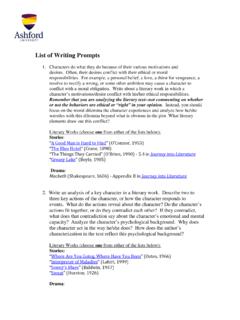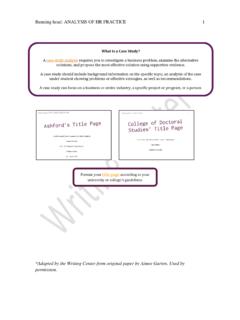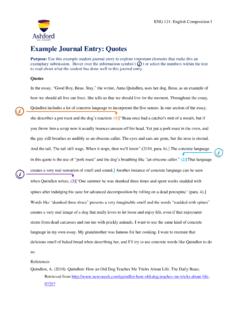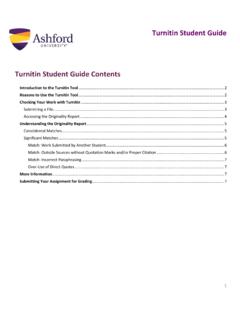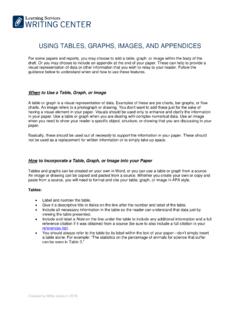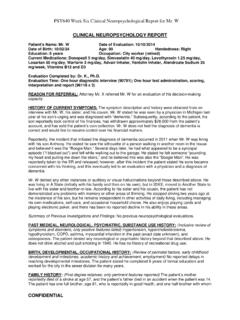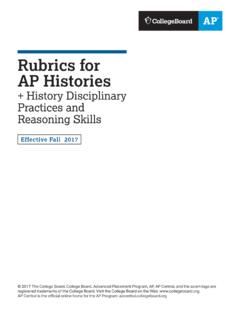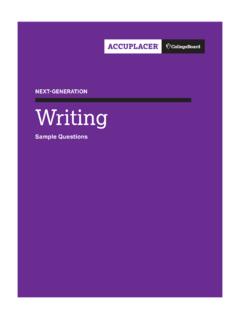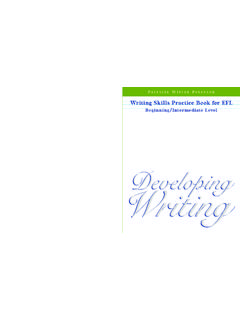Transcription of WRITING A GOOD DISCUSSION BOARD POST
1 1 Created by Millie Jones in 2016 WRITING A good DISCUSSION BOARD post There are several key steps that you ll need to follow in order to write a complete and engaging DISCUSSION BOARD post . For every DISCUSSION post , you need to: 1. UNDERSTAND what the DISCUSSION is asking you to do 2. READ all required or supplemental materials 3. WRITE the post , and 4. REVIEW using the DISCUSSION post Checklist Now, let s go through each of these important steps in more detail. First, break down the instructions of the DISCUSSION and take notes to understand exactly what you need to do to complete it. a. Identify the purpose or goal of the DISCUSSION post and how it relates to the course concepts under review for the week.
2 B. Be sure to note any required course reading, such as the instructor guidance, chapters from your textbook, or an article or webpage. c. Look for key terms in the instructions these are terms or course concepts that you will see in the reading for the week, or that you have become familiar with in earlier weeks of the course. Be sure to underline, highlight, or note these key words, as these are the themes that you will focus on in your DISCUSSION post this week. d. Make note of any key questions or directives that you are asked to address. If these questions/directives are already in a bulleted or numbered list, great! But if they are not, go ahead and number them so you can later use them as a checklist for yourself.
3 *Note- Directives are action verbs in the instructions that tell you what to do. Examples that you might see include Define, Explain, Describe, or Discuss. The WRITING Center s guide on Understanding the Verbs in Your Prompt can help you understand the expectations of each of these directive words. e. Note any additional requirements such as word count or APA formatting. f. Finally, if a grading rubric is provided, be sure to review each part of it. The rubric can be used as a checklist to ensure you have completed each of the requirements of the DISCUSSION . This may sound like a lot of work now, but it actually only takes 10 to 15 minutes to go through the instructions and make notes on what needs to be accomplished.
4 These few minutes will save you time when you begin WRITING and will help you to write a better post . 2 Created by Millie Jones in 2016 Here is an example of a DISCUSSION prompt where each of these elements has been marked: In Chapter 2 of your text, Bevan and Sole (2014) lay out many psychological concepts concerning the self. These key elements of human psychology are central to how we communicate with ourselves (intrapersonal communication) and others (interpersonal communication). Prepare: As you prepare to write your DISCUSSION for this topic, take a few moments to do the following: Review Chapter 2 in your text. Focus on the segments of the book on self-concept, self-image, and self-esteem.
5 Review the grading rubric and note that 25% of your grade is based on your application of course material (Content/Subject Knowledge) and 25% is based on your ability to demonstrate you are thinking critically and presenting original ideas. Reflect: Take time to reflect on how your self-concept, self-image, or self-esteem have affected the way you communicate with others and, perhaps, how you believe others respond to you. Write: Based on the information in Chapter 2 Define self-concept, self-image, and self-esteem and write at least two sentences on each term. Provide an example of how your self-concept, self-image, or self-esteem has affected your interpersonal communication.
6 Use specific examples to illustrate your points. Your initial response should be 200 to 300 words in length, cited in APA style, and is due by Thursday, Day 3. Second, complete any required or supplemental reading. Your discussions are related to what you are learning and reading about in your course. So, even if it is not explicitly stated, you are expected to use concepts and ideas from your weekly reading as the basis for answering your DISCUSSION . As you read through your required or supplemental materials, be sure to note any key terms that you also saw in the DISCUSSION post instructions. Also, if you see anything in the reading that relates to or helps you to address the questions or directives in your DISCUSSION post , make a note of it or highlight it so you can refer back to it.
7 This will help you to give examples, quote, paraphrase, or summarize when you start WRITING . If you need to add additional research to your post , be sure to utilize expert research advice and guidance from the Ashford Library, which is available 24/7 by going to the WRITING Center & Library tab in your course and clicking on the Library link. The third step is WRITING your DISCUSSION post . You ve done the required reading and you ve learned a lot about the concepts and ideas for this week. Now you are ready to show your instructor that you understand the concepts and can apply them through WRITING . c. Key terms are shown throughout in blue. b. The required course reading is shown in green.
8 E. Here, the additional requirements are listed in red. f. A grading rubric is given in this DISCUSSION prompt. d. Here in purple, the directives (action items) are given. a. Here, the purpose or goal is shown in orange. 3 Created by Millie Jones in 2016 First, refer back to the instructions where you have noted the questions or directives that you are asked to respond to. There should be several of these. Keep these in front of you as you are WRITING . Next, for each bulleted or numbered item in the prompt, write a complete paragraph as a response to it. This means that if you have 2 bulleted items in the instructions, you need to have 2 fully developed paragraphs in your post and each of the directives given in the prompt should be addressed within these paragraphs.
9 When WRITING , create a topic sentence that indicates what you will address in that paragraph and the point you want to make. In the supporting sentences, give personal examples (if asked to do so), and use a quote, paraphrase, or summary (or a combination of these) from the readings to help you address that directive or question and support your answers. Write a conclusion sentence for each paragraph that shares how the information in that paragraph relates to the overall course concept of the DISCUSSION post . See the WRITING Center s guide on Paragraph Development for more help. The most important part of each of these paragraphs is the supporting sentences. This is where you will show your instructor that you both understand the reading and can apply what you have learned to the DISCUSSION for the week.
10 This means integrating what you read and not simply inserting a quote, paraphrase, or summary into your post . This is critical and may affect your grade. For help on why and how to do this, watch the WRITING Center s guide on Integrating your Readings, which includes information on how to cite your sources as well. Finally, refer back to any additional requirements from the instructions, such as the word count or APA formatting. Include these additional requirements in your WRITING . And finally, before you hit the post Response button, be sure to take a few minutes and review your post . The following is an easy checklist that you can keep on hand to ensure that all of your DISCUSSION posts are complete and engaging.
